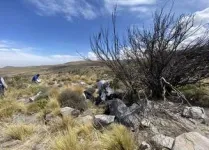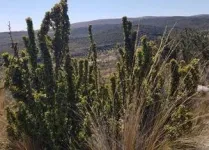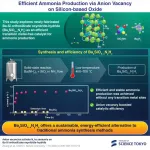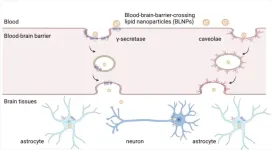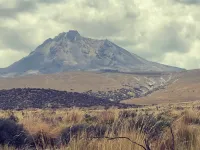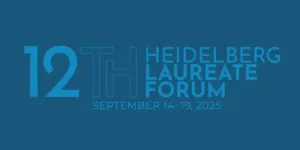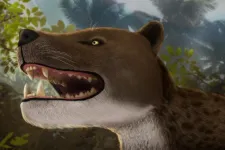(Press-News.org) In the parable of the blind men and the elephant, several blind men each describe a different part of an elephant they are touching – a sharp tusk, a flexible trunk, or a broad leg – and disagree about the animal’s true nature. The story illustrates the problem of understanding an unseen, or latent object based on incomplete individual perceptions. Likewise, when researchers study brain dynamics based on recordings of a limited number of neurons, they must infer the latent patterns of brain dynamics that generate these recordings.
“Suppose you and I both engage in a mental task, such as navigating our way to work. Can signals from a small fraction of neurons tell us that we use the same or different mental strategies to solve the task?” says Pierre Vandergheynst, head of the Signal Processing Laboratory LTS2 in EPFL’s School of Engineering. “This is a fundamental question to neuroscience, because experimentalists often record data from many animals, yet we have limited evidence as to whether they represent a given task using the same brain patterns.”
Vandergheynst and former postdoc Adam Gosztolai, now an assistant professor at the AI Institute of the Medical University of Vienna, have published a geometric deep learning approach in Nature Methods that can infer latent brain activity patterns across experimental subjects. MARBLE (Manifold Representation Basis Learning) achieves this by breaking down electrical neural activity into dynamic patterns, or motifs, that are learnable by a geometric neural network. In experiments on macaque and rat brain recordings, the scientists used MARBLE to show that when different animals used the same mental strategy to reach an arm or navigate a maze, their brain dynamics were made up of the same motifs.
A geometric neural net for dynamic data
Traditional deep learning is not suited to understanding dynamic systems that change regularly as a function of time, like firing neurons or flowing fluids. These patterns of activity are so complex that they are best described as geometric objects in high-dimensional spaces. One example of such an object is a torus, which resembles a donut.
As Gosztolai explains, MARBLE is unique because it learns from within curved spaces –natural mathematical spaces for complex patterns of neuronal activity. “Inside the curved spaces, the geometric deep learning algorithm is unaware that these spaces are curved. Thus, the dynamic motifs it learns are independent of the shape of the space, meaning it can discover the same motifs from different recordings.”
The EPFL team tested MARBLE on recordings of the pre-motor cortex of macaques during a reaching task, and of the hippocampus of rats during a spatial navigation task. They found that MARBLE’s representations based on single-neuron population recordings were much more interpretable than those from other machine learning methods, and that MARBLE could decode brain activity to arm movements with greater accuracy than other methods.
Moreover, because MARBLE is grounded in the mathematic theory of high-dimensional shapes, it was able to independently patch together brain activity recordings from different experimental conditions into a global structure. This gives it an edge over other methods, which must work with a user-defined global shape.
Brain-machine interfaces and beyond
In addition to furthering our understanding of the dynamics underpinning brain computations and behavior, MARBLE could use neural activity data to recognize the brain’s dynamic patterns when carrying out specific tasks, like reaching, and transform them into decodable representations that could then be used to trigger an assistive robotic device. However, the researchers emphasize that MARBLE is a powerful tool that could be applied across scientific fields and datasets to compare dynamic phenomena.
“The MARBLE method is primarily aimed at helping neuroscience researchers understand how the brain computes across individuals or experimental conditions, and to uncover – when they exist – universal patterns,” Vandergheynst says. “But its mathematical basis is by no means limited to brain signals, and we expect that our tool will benefit researchers in other fields of life and physical sciences who wish to jointly analyze multiple datasets.”
END
A geometric deep learning method for decoding brain dynamics
EPFL scientists have developed a geometric deep learning method that can create a coherent picture of neuronal population activity during cognitive and motor tasks across experimental subjects and conditions
2025-02-17
ELSE PRESS RELEASES FROM THIS DATE:
Novel catalyst development for sustainable ammonia synthesis
2025-02-17
As the world moves toward sustainability, the demand for efficient alternatives across industries continues to grow. Ammonia, a key chemical used in fertilizers, explosives, and various other products, is primarily synthesized through the energy-intensive Haber-Bosch process. This process requires extremely high temperatures and pressures, contributing to global carbon dioxide emissions. Conventional catalysts, such as iron and ruthenium, rely on these harsh conditions to drive the reaction. However, a recent study by researchers from Institute of Science Tokyo, the National Institute for Materials Science, and Tohoku University, Japan, led by Professor Masaaki Kitano, explores ...
Researchers identify DNA changes, biological pathways associated with inherited cancer risk
2025-02-17
Thousands of single changes in the nucleotides that make up the human genome have been associated with an increased risk of developing cancer. But until now, it’s not been clear which are directly responsible for the uncontrolled cellular growth that is the hallmark of the disease and which are simply coincidences or minor players.
Stanford researchers have conducted the first large-scale screen of these inherited changes, called single nucleotide variants, and homed in on fewer than 400 that are essential to initiate and drive cancer growth. These variants control several common biological ...
New lipid nanoparticle platform delivers mRNA to the brain through the blood-brain barrier
2025-02-17
New York, NY [February 17, 2025]—Scientists at the Icahn School of Medicine at Mount Sinai have developed a lipid nanoparticle system capable of delivering messenger RNA (mRNA) to the brain via intravenous injection, a challenge that has long been limited by the protective nature of the blood-brain barrier.
The findings, in mouse models and isolated human brain tissue, were published in the February 17 online issue of Nature Materials [10.1038/s41563-024-02114-5]. They demonstrate the potential of this technology to pave the way for ...
Wildfires in the Andes cause severe soil degradation and hinder ecosystem recovery
2025-02-17
In September 2018, a wildfire burned nearly two thousand hectares of shrubland on the Pichu Pichu volcano, an ecologically significant area in the Peruvian Andes. Unlike Mediterranean ecosystems, where vegetation has evolved strategies to withstand fire, the volcanic soils of Arequipa—one of the driest regions in the world—are not adapted to wildfire disturbances. A Miguel Hernández University of Elche (UMH) research team collected and analyzed soil samples from the burned area at 3,700 meters above sea level to understand how these fragile ecosystems ...
Men and boys matter: Psychology professor reveals hidden issues we need to talk about
2025-02-17
These include those linked to body image, fatherhood and sexual relationships. His latest book - Current Issues Facing Men and Boys – also argues that men struggle to negotiate harmful notions of masculinity and are not included in conversations around gender.
Current Issues Facing Men and Boys urges the public, policymakers, practitioners and other key stakeholders to explore and support policies and practices that promote male wellbeing. This book comes as the UK government announces plans for the country's first men's health strategy, aiming ...
1 in 6 parents support teens getting non-surgical cosmetic procedures with parental consent
2025-02-17
For teens who may be self-conscious about issues such as acne scarring or discolored teeth, non-surgical cosmetic procedures are an increasingly popular way to address their concerns.
And some parents are supportive of this decision, a national poll suggests, with a sixth saying teenagers should be allowed to receive these types of aesthetic treatments for any reason as long as they have parental approval.
But half of parents only support teens getting non-surgical cosmetic procedures if there’s a valid reason – and their beliefs about which reasons count as valid differ – according to ...
Journalist travel grants available for 12th Heidelberg Laureate Forum
2025-02-17
This September, recipients of the Abel Prize, ACM A.M. Turing Award, ACM Prize in Computing, Fields Medal, IMU Abacus Medal and the Nevanlinna Prize are invited to gather in Heidelberg to meet with 200 young researchers from all over the world at the 12th Heidelberg Laureate Forum (HLF). In order to reach a broader, more diverse and international audience, the Heidelberg Laureate Forum Foundation (HLFF) encourages journalists to cover the event and affords them the chance to interact with the preeminent scientists of mathematics and computer science. The 12th HLF will take ...
Are we still primitive? How ancient survival instincts shape modern power struggles
2025-02-17
The evolutionary roots of human dominance and aggression remain central to social and political behaviour, and without conscious intervention these primal survival drives will continue to fuel inequality and division.
These are the arguments of a medical professor who, as global conflicts rise and democracies face growing challenges, says understanding how dominance and tribal instincts fuel division is more critical than ever.
In A New Approach to Human Social Evolution, Professor Jorge A. Colombo MD, PhD explores neuroscience, anthropology, and behavioural science to provide a new perspective on human social evolution.
He argues that fundamental behavioural drives ...
Near-complete skull discovery reveals ‘top apex’, leopard-sized “fearsome” carnivore
2025-02-17
A rare discovery of a nearly complete skull in the Egyptian desert has led scientists to the “dream” revelation of a new 30-million-year-old species of the ancient apex predatory carnivore, Hyaenodonta.
Bearing sharp teeth and powerful jaw muscles, suggesting a strong bite, the newly-identified ‘Bastetodon’ was a leopard-sized “fearsome” mammal. It would have been at the top of all carnivores and the food chain when our own monkey-like ancestors were evolving.
Findings, published in the peer-reviewed Journal of Vertebrate Paleontology, detail ...
Reintroducing wolves to Scottish Highlands could help address climate emergency
2025-02-17
University of Leeds news
Embargoed until 05:01 GMT, 17 February
Reintroducing wolves to the Scottish Highlands could lead to an expansion of native woodland which could take in and store one million tonnes of CO2 annually, according to a new study led by researchers at the University of Leeds.
The team modelled the potential impact that wolves could have in four areas classified as Scottish Wild Land, where the eating of tree saplings by growing red deer populations is suppressing natural regeneration of trees and woodland.
They used a predator–prey model to ...
LAST 30 PRESS RELEASES:
Post-stroke injection protects the brain in preclinical study
Cardiovascular risk score predicts multiple eye diseases
Health: estimated one in ten British adults used or interested in GLP-1 medications for weight loss
Exercise to treat depression yields similar results to therapy
Whooping cough vaccination for pregnant women strengthens babies’ immune system
Dramatic decline in new cases of orphanhood in Uganda driven by HIV treatment and prevention programs
Stopping weight loss drugs linked to weight regain and reversal of heart health markers
Higher intake of food preservatives linked to increased cancer risk
Mass General Brigham–developed cholera vaccine completes phase 1 trial
First experimental validation of a “150-year-old chemical common sense” direct visualization of the molecular structural changes in the ultrafast anthracene [4+4] photocycloaddition reaction
Lack of support for people on weight loss drugs leaves them vulnerable to nutritional deficiencies, say experts
Dogs’ dinners can have greater climate impact than owners’
Are you ready to swap salmon for sprats and sardines?
1.6 million UK adults used weight loss drugs in past year
American College of Cardiology comments on new dietary guidelines for Americans
American Society of Gene & Cell Therapy and Orphan Therapeutics Accelerator partner to advance and commercialize promising rare disease treatments
One in 14 patients having day case surgery have new or worse chronic pain 3 months after their operation
New study highlights link between eviction rates and gun violence
Heatwaves heat up soil but not toxin levels in rice, study finds
Digital modeling reveals where construction carbon emissions really come from
Turning farm waste into water filters
New study shows how the spleen helps the immune system accept a transplant
New Mayo Clinic study advances personalized prostate cancer education with an EHR-integrated AI agent
Researchers identify novel therapeutic target to improve recovery after nerve injury
Microbes in breast milk help populate infant gut microbiomes
Reprogramming immunity to rewrite the story of Type 1 diabetes
New tool narrows the search for ideal material structures
Artificial saliva containing sugarcane protein helps protect the teeth of patients with head and neck cancer
Understanding the role of linear ubiquitination in T-tubule biogenesis
Researchers identify urban atmosphere as primary reservoir of microplastics
[Press-News.org] A geometric deep learning method for decoding brain dynamicsEPFL scientists have developed a geometric deep learning method that can create a coherent picture of neuronal population activity during cognitive and motor tasks across experimental subjects and conditions

